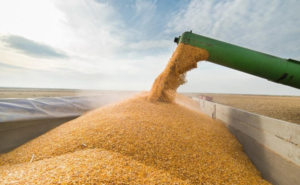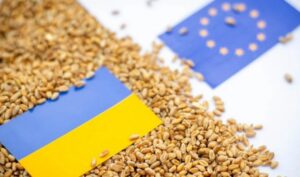
In September 2025, Ukraine exported 2.84 million tons of agricultural products, which is 38% less than in the same month last year (4.6 million tons), according to the Ukrainian Grain Association (UGA) on Facebook.
The industry association noted that wheat exports fell by 21% to 1.83 million tons, corn exports fell 8.6 times to 61,000 tons, rapeseed exports fell 3.2 times to 238,000 tons, and soybean exports fell three times to 78,000 tons. Sunflower oil exports fell by 42% to 203,000 tons, and legume exports fell by 24% to 177,000 tons.
The only export growth in September was for barley, which rose by 4% to 238,000 tons.
At the same time, 90% of agricultural products were exported through the ports of Odessa, and 2% through the ports of the Danube. The rest of the agricultural products were transported across the western borders by rail (6%) and trucks (2%).
At the same time, exports through the ports of Odessa in September 2025 decreased by 29.2% compared to the same period last year and amounted to 2.522 million tons, through the ports of the Danube by 6.4 times to 68 thousand tons, by rail by 2.6 times, to 175 thousand tons, and by truck by 3.2 times, to 55 thousand tons.

In January-September of this year, Ukraine increased its ferroalloy exports by 31% in physical terms compared to the same period last year, to 77,514 thousand tons.
According to statistics released by the State Customs Service (SCS), in monetary terms, ferroalloy exports increased by 22.5% to $86.926 million.
The main exports were to Poland (29.02% of shipments in monetary terms), Algeria (21.98%), and Turkey (20.37%).
In addition, in the first nine months of 2025, Ukraine imported 30,341 thousand tons of this product, a decrease of 57.7% compared to the same period in 2024. In monetary terms, imports fell by 53% to $56.990 million. Imports were mainly from Norway (20.88%), Kazakhstan (15.72%), and France (10.58%).
As reported, the Pokrovsky Mining and Processing Plant (PGZK, formerly Ordzhonikidze Mining and Processing Plant) and the Marganetsky Mining and Processing Plant (MGZK, both in Dnipropetrovsk region), which are part of the Privat Group, stopped mining and processing raw manganese ore in late October-early November 2023, while NZF and ZZF stopped smelting ferroalloys. In the summer of 2024, ferroalloy plants resumed production at a minimum level.
PGZK and MGZK did not produce any products in 2024, while in 2023, PGZK produced 160.31 thousand tons of manganese concentrate, and MGZK was idle.
In 2024, Ukraine reduced its exports of ferroalloys in physical terms by 4.45 times compared to 2023, to 77,316 tons from 344,173 tons. and in monetary terms, it decreased by 3.4 times, to $88.631 million from $297.595 million. At the same time, the main exports were to Poland (27.40% of supplies in monetary terms), Turkey (21.53%), and Italy (19.82%).
In addition, last year Ukraine imported 82,259 thousand tons of this product compared to 14,203 thousand tons in 2023 (a 5.8-fold increase). In monetary terms, imports increased 3.3 times, from $42.927 million to $140.752 million. Imports were mainly from Poland (32.71%), Norway (19.55%), and Kazakhstan (13.9%).
The business of ZZF, NZF, Stakhanov ZF (located at NKT), Pokrovsky and Marganetsky GZK was organized by PrivatBank prior to the nationalization of the financial institution. The Nikopol Ferroalloy Plant is controlled by the EastOne group, created in the fall of 2007 as a result of the restructuring of the Interpipe group, as well as the Privat group.

In January-September of this year, Ukraine increased its exports of processed cast iron in physical terms by 62.2% compared to the same period last year, to 1 million 401,147 thousand tons.
According to statistics released by the State Customs Service (SCS) on Wednesday, during the specified period, cast iron exports in monetary terms increased by 65.4% to $548.121 million.
At the same time, exports were mainly to the United States (79.62% of shipments in monetary terms), Italy (9.64%), and Turkey (3.13%).
In the first nine months of this year, the country imported 38,000 tons worth $76,000 from Germany (51.32%) and Brazil (48.68%), while in January-September 2024, 25 tons of pig iron worth $60,000 were imported.
As reported, on March 12 of this year, in accordance with President Donald Trump’s decision, the US began imposing a 25% tariff on imports of Ukrainian steel products, except for cast iron.
In 2024, Ukraine reduced its exports of processed cast iron by 3.4% in physical terms compared to 2023, to 1 million 290.622 thousand tons, and by 6.1% in monetary terms, to $500.341 million. Exports were mainly to the US (72.64% of shipments in monetary terms), Turkey (8.03%), and Italy (7.30%).
For the whole of 2024, the country imported 38 tons of pig iron worth $90 thousand from Germany, while for the same period in 2023, it imported 154 tons of pig iron worth $156 thousand.

Biosphere Corporation has announced its intention to increase its export share in total sales from the current 30% to 50% by 2030.
According to Iryna Nesterenko, vice president of operations at the corporation, as reported to Interfax-Ukraine, exports accounted for 15% of sales before the full-scale war, and by the end of this year, they will grow to 30%, half of which will be to EU countries.
“Our first step abroad took place back in 2006 – shipments of our Freken BOK and Smile brands to Moldova. After that, we actively expanded our presence in Central Asia and the Caucasus (Georgia, Armenia, Azerbaijan), and in 2022, we began to shift our focus to Europe,” Nesterenko described the historical path of expansion.
She recalled that in the fall of 2022, Biosphere acquired the Austrian brand Alufix, along with production facilities in Romania and branches in four EU countries, which significantly strengthened the company’s position in Europe.
Biosphere Corporation is Ukraine’s largest manufacturer and distributor of household and personal hygiene products and one of the major players in this industry in Eastern Europe and Central Asia. The company’s products are represented in more than 25 countries, and its production facilities consist of seven factories in Ukraine and Europe. Created over more than 27 years of activity, Biosphere’s portfolio of 21 own brands includes, among others, Freken BOK, Smile, Novita, Lady Cotton, PRO service, Alufix, and Vortex. At the end of 2023, the company launched a new Tea&Food division with its own Cupsoul production, represented by such tea brands as Graff and Ritz Barton.
In February this year, the founder and CEO of the corporation, Andriy Zdesenko, announced that last year the group’s key businesses increased their revenue by approximately 20% to UAH 7.5 billion, and that this growth is expected to continue in 2025.

In September 2025, Ukraine exported 3.7 million tons of agricultural products, which is 6.5% less than in the previous month and 25% less than in the same period of 2024, according to the Ukrainian Agribusiness Club (UAC).
“The two main reasons for this trend are the two- to three-week delay in harvesting compared to the same period last year and the introduction of duties on soybean and rapeseed exports, which significantly reduced shipments, in particular due to the lack of an established mechanism. Oilseed exports fell by 53%,” experts explained.
Analysts noted that the structure of exports in September 2025 was as follows: grain crops – 2.4 million tons (wheat – 86%, barley – 12%, corn – 2%), which is 1% less than the previous month; oilseeds – down 53% to 322.4 thousand tons (rapeseed – 73%, soybeans – 24%, flax – 2%); vegetable oils – up 48% to 313.3 thousand tons (sunflower oil – 53%, rapeseed – 35% and soybean – 12%); oilcake after extraction of vegetable oils – 281.0 thousand tons (sunflower – 62%, soybean – 38%), which corresponds to last year’s figure. Exports of other types of agricultural products increased by 5% to 340,000 tons.
“Next month, we expect an increase in exports of agricultural products due to an increase in the volume of late crops harvested and the optimization of soybean and rapeseed export processes,” the UACB concluded.

In January-July 2025, Ukraine exported agricultural and food products worth $5.73 billion to the European Union, which is $891 million, or 13%, less than in the same period last year, according to an EU report.
At the same time, Ukraine managed to maintain its fourth place in the list of suppliers of agricultural products to the EU during this period. Ahead of it are Brazil ($9.1 billion), the United Kingdom ($7.8 billion), and the United States ($6.9 billion).
The ranking of the largest suppliers of agricultural products to the EU also includes China ($5.24 billion), Côte d’Ivoire ($5.05 billion), Turkey ($3.68 billion), Vietnam ($2.81 billion), Argentina ($2.57 billion), and Switzerland ($2.51 billion).
In total, agricultural imports to the EU in January-July 2025 are estimated at $96.8 billion (+16%).
Agricultural exports from the EU during the same period amounted to $118.7 billion (+2%). At the same time, $2.1 billion (+17%) worth of goods were supplied to Ukraine.